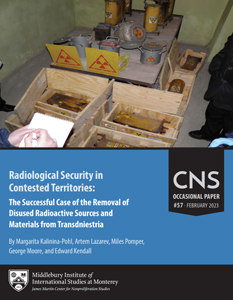February 14, 2023
Margarita Kalinina-Pohl, Artem Lazarev, Miles Pomper, George Moore, and Edward Kendall
From the Preface:
 Radioactive materials, such as cesium-137 and cobalt-60, are located in more than 100 countries and in every region of the world. They are used widely for medical, scientific, and industrial purposes—but can also be used maliciously as key ingredients in radiological dispersal devices (RDDs), the most notorious type of which is known as a “dirty bomb” which disperses radiological material using explosives.
Radioactive materials, such as cesium-137 and cobalt-60, are located in more than 100 countries and in every region of the world. They are used widely for medical, scientific, and industrial purposes—but can also be used maliciously as key ingredients in radiological dispersal devices (RDDs), the most notorious type of which is known as a “dirty bomb” which disperses radiological material using explosives.
Though responsibility for the development and enforcement of regulations pertaining to the safety, security, and full cycle management of radioactive sources rests with state authorities, thousands of radioactive sources today exist in areas without the clear presence of a state. Such areas are often characterized by conflict and rampant criminal activity as a result of weak or nonexistent governance.
Radioactive material located in these contested or poorly governed territories poses a serious risk for regional and global security, as they could be trafficked illegally and used in an RDD or for other malicious purposes anywhere in the world.
International and regional organizations face a range of political and legal challenges in helping secure radioactive materials in contested territories since the sources in question are often found beyond the de facto or de jure control of UN-recognized states. Addressing the safety and security of these materials requires stakeholders to navigate uncharted legal issues and play creative roles to secure or transport these materials into safer areas.
This report covers one of the few success stories involving the removal or elimination of dangerous radioactive sources from a contested territory. It describes and assesses the lessons learned from the Republic of Moldova’s removal of approximately 2,700 disused radioactive sources and materials from the breakaway region of Transdniestria. Though these materials were located in a territory that is not de facto governed by an International Atomic Energy Agency member state, creative diplomacy by the Republic of Moldova, the Pridnestrovian Moldovan Republic (the unrecognized authorities in Transdniestria), the Organization for Security and Cooperation in Europe (OSCE), and other key stakeholders contributed to the success of this removal operation. The report describes these diplomatic efforts and analyzes the significant political, legal, and technical factors that contributed to the success of this multiyear mission. While recognizing that each country and conflict is unique, we hope that this case study can serve as a successful model of cooperation and confidence building for reducing radiological risks in contested territories around the world.
Continue reading: “Radiological Security in Contested Territories”
